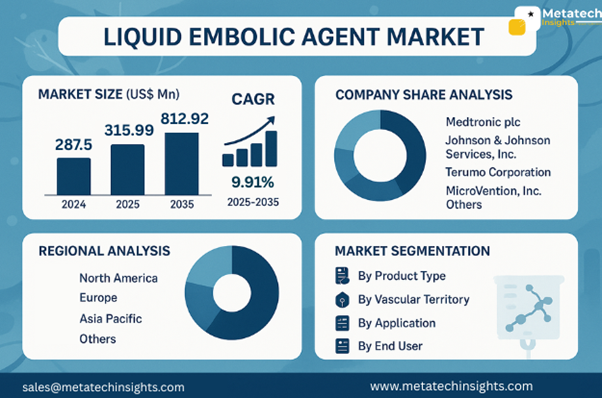Global Liquid Embolic Agent Market to Hit USD 812.92 Mn by 2035 | CAGR 24.72%
10 Aug 2025 | Report ID: MI3366 | Industry: Healthcare | Pages: 220 | Forecast Year: 2025-2035

Read more about this report- Global Liquid Embolic Agent Market to Hit USD 812.92 Mn by 2035 | CAGR 24.72%
The Liquid Embolic Agent Market is valued at USD 287.5 Million in 2024.
The Liquid Embolic Agent Market will achieve USD 812.92 Million by 2035 through a projected 9.91% CAGR from 2025 to 2035.
The Liquid Embolic Agent Market is propelled by the rising prevalence of cerebrovascular and peripheral vascular disorders, increasing adoption of minimally invasive procedures, and advancements in embolization technologies. The increasing number of people seeking proper treatment for an aneurysm, arteriovenous malformations (AVMs), and other vascular irregularities, due to the addition of some people shifting towards using cost-effective and safer methods of therapy, is also contributing to the market growth. Innovations like better embolic products and medical devices that deliver products more efficiently have led to better results in the procedures, increasing clinical acceptance in a broader way.
Included in the market segmentation based on product type, we have the liquid embolic agents, which are cyanoacrylate-based, ethylene vinyl alcohol copolymer (EVOH), and others. Out of these, the agents based on EVOH are experiencing a fast-paced adoption as they offer better controllability and a reduced rate of complications. Also, new biodegradable and polymer-based agents are being increasingly used due to their good safety attributes and favorable results in complex vascular interventions.
The market, using the basis of vascular territory, is divided into cerebral, peripheral, and other vascular territories. The highest number of cases belongs to the cerebral vascular segment, because intracranial aneurysms and AVMs that need embolization are numerous. Meanwhile, the peripheral vascular segment is in steady growth owing to the increase in awareness and more diagnostic opportunities introduced about diseases such as gastrointestinal bleeding and tumors, among others.
Under the application, the market includes aneurysm treatment, arteriovenous malformations, tumors, gastrointestinal bleeding, etc. The largest share is occupied by the aneurysm treatment segment, which is facilitated by more screening and the fact that minimally invasive embolization therapies are becoming preferable to the traditional surgical ones. There is also the growth in tumor embolization procedures, criteria that are reinforced by the increasing rates of cancer cases and the need to get palliative care services.
The end-user landscape includes hospitals, ambulatory surgical centers, and specialty clinics. Hospitals are the first to embrace the market because of the better infrastructure and access to special interventional radiology teams. The ambulatory surgical centers and clinics are slowly adopting the trend of outpatient minimally invasive procedures to better accommodate the convenience of their patients as well as lower the expense of healthcare.
The market growth is also facilitated by positive regulatory approvals, growth in health care spending, and growing investments in R&D by major industry players. It is believed that the focus toward establishing biocompatible agents that would be safer and could have an easier administration method is likely to continue. Also, the rationale that lies in the increasing awareness of physicians and patients regarding the benefits of embolization is widening the possible user base to a global one.
In terms of geography, North America takes over a larger market share with sophisticated healthcare systems, a high rate of vascular diseases, and the powerful force of market leaders. Asia Pacific is the rising sector owing to the rising healthcare investments, advancement of diagnostic facilities, and the escalating use of minimally invasive treatment adopted in the emerging economies. The situation in Europe is not much different and is supported by well-developed healthcare facilities and initiatives by the government that promote the use of interventional procedures.
The prominent participants in the Liquid Embolic Agent Market that are striving to push innovations and competitive expansion are Medtronic plc, Johnson & Johnson Services, Inc., Terumo Corporation, MicroVention, Inc., and other remarkable enterprises. These organizations are undertaking active strategies to enlarge their product portfolios and form collaborations, and they invest in clinical research to satisfy the increased demand for safe, effective, and convenient embolic solutions worldwide.
Maximize your value and knowledge with our 5 Reports-in-1 Bundle - over 40% off!
Our analysts are ready to help you immediately.
